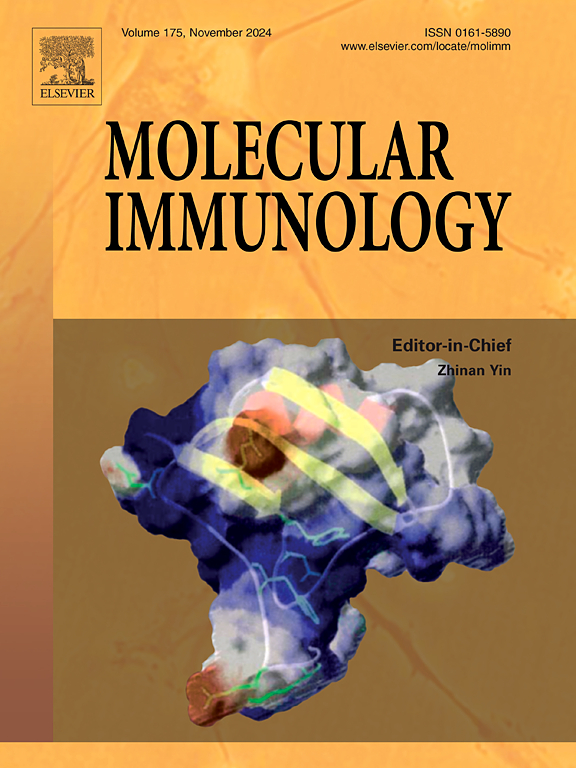Network pharmacology and in vivo investigation of the growth and immunity-enhancing mechanisms of Tetramethylpyrazine (TMP) in Litopenaeus vannamei
IF 3
3区 医学
Q2 BIOCHEMISTRY & MOLECULAR BIOLOGY
引用次数: 0
Abstract
In this study, the shrimp (L. vannamei, 0.89 ± 0.04 g) were fed formulated diets supplemented with Tetramethylpyrazine for six weeks under routine aquaculture conditions, followed by a three-day challenge with White Spot Syndrome Virus (WSSV). The results showed that dietary TMP supplementation significantly improved the specific growth rate and weight gain rate, while reducing the feed conversion ratio. During the viral challenge, the immune protection rate of shrimp was significantly enhanced (P < 0.05). Further analysis using network pharmacology, molecular docking, and quantitative real-time PCR demonstrated that TMP exhibited strong binding affinities with hypoxia-inducible factor 1-alpha (HIF1A), prostaglandin synthase (PTGSH2), and nuclear transcription factors (Relish and Dorsal). At the transcriptional level, TMP significantly inhibited the expression of HIF1A and sterol regulatory element-binding protein (SREBP), while upregulating adiponectin receptor (AdipoR) expression. TMP also promoted lipid catabolismand cholesterol efflux-related genes, while downregulating lipid synthesis genes. Moreover, TMP enhanced the expression of arachidonic acid pathway-related genes and antioxidant enzymes, leading to reduced levels of malondialdehyde (MDA) and blood lipids. Regarding immune stimulation, TMP activated the NF-κB (Dorsal, Relish) signaling pathway, upregulated the expression of antimicrobial peptides, and reduced inflammatory cytokine levels. Under WSSV infection, TMP suppressed viral replication by downregulating HIF1A and VEGF expression (P < 0.05), suggesting that TMP exerts its antiviral effect. High-throughput sequencing of the intestinal microbiota indicated that TMP supplementation increased the abundance of beneficial bacteria and decreased the abundance of harmful bacteria, thereby improving intestinal mucosal barrier function. In conclusion, considering both growth performance and physiological health, we recommend an optimal TMP supplementation level of 150 mg/kg in shrimp feed.
四甲基吡嗪(TMP)在凡纳滨对虾(Litopenaeus vannamei)体内生长和免疫增强机制的网络药理学研究
在常规养殖条件下,对凡纳米对虾(l.v annamei, 0.89 ± 0.04 g)投喂添加tetrameylpyrazine的配方饲料6周,然后用白斑综合征病毒(WSSV)攻毒3天。结果表明,饲粮中添加TMP显著提高了特定生长率和增重率,降低了饲料系数。在病毒攻毒过程中,对虾的免疫保护率显著提高(P <; 0.05)。通过网络药理学、分子对接和实时荧光定量PCR的进一步分析表明,TMP与缺氧诱导因子1- α (HIF1A)、前列腺素合成酶(PTGSH2)和核转录因子(enjoy和Dorsal)具有很强的结合亲和力。在转录水平上,TMP显著抑制HIF1A和甾醇调节元件结合蛋白(SREBP)的表达,同时上调脂联素受体(AdipoR)的表达。TMP还促进脂质分解代谢和胆固醇外排相关基因,同时下调脂质合成基因。此外,TMP还增强了花生四烯酸途径相关基因和抗氧化酶的表达,导致丙二醛(MDA)和血脂水平降低。在免疫刺激方面,TMP激活NF-κB (Dorsal, enjoy)信号通路,上调抗菌肽的表达,降低炎症细胞因子水平。在WSSV感染下,TMP通过下调HIF1A和VEGF表达抑制病毒复制(P <; 0.05),说明TMP发挥了抗病毒作用。肠道菌群高通量测序结果显示,补充TMP增加了有益菌的丰度,降低了有害菌的丰度,从而改善了肠道黏膜屏障功能。综上所述,综合考虑虾的生长性能和生理健康,建议在虾饲料中添加150 mg/kg的TMP为最佳水平。
本文章由计算机程序翻译,如有差异,请以英文原文为准。
求助全文
约1分钟内获得全文
求助全文
来源期刊

Molecular immunology
医学-免疫学
CiteScore
6.90
自引率
2.80%
发文量
324
审稿时长
50 days
期刊介绍:
Molecular Immunology publishes original articles, reviews and commentaries on all areas of immunology, with a particular focus on description of cellular, biochemical or genetic mechanisms underlying immunological phenomena. Studies on all model organisms, from invertebrates to humans, are suitable. Examples include, but are not restricted to:
Infection, autoimmunity, transplantation, immunodeficiencies, inflammation and tumor immunology
Mechanisms of induction, regulation and termination of innate and adaptive immunity
Intercellular communication, cooperation and regulation
Intracellular mechanisms of immunity (endocytosis, protein trafficking, pathogen recognition, antigen presentation, etc)
Mechanisms of action of the cells and molecules of the immune system
Structural analysis
Development of the immune system
Comparative immunology and evolution of the immune system
"Omics" studies and bioinformatics
Vaccines, biotechnology and therapeutic manipulation of the immune system (therapeutic antibodies, cytokines, cellular therapies, etc)
Technical developments.
 求助内容:
求助内容: 应助结果提醒方式:
应助结果提醒方式:


